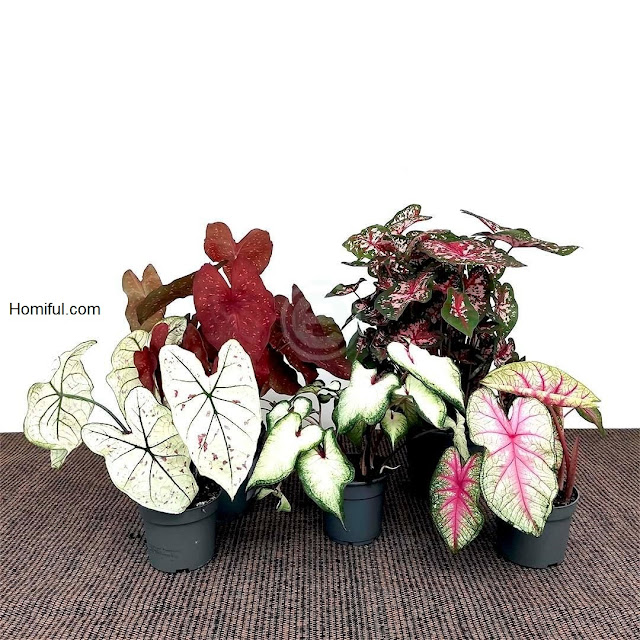 |
| How to Care for Caladiums, Indoors and Out |
Homiful.com -- Caladiums have become one of the most popular foliage plants for gloomy or semi-shady gardens, with many new arrivals being sun tolerant, thanks to their lush colorful leaves, many of which are larger than the palm of your hand. With a little TLC, these exotic shade dwellers can put on a show that rivals any flowering plant. Let's begin by these "How to Care for Caladiums, Indoors and Out"!
About Caladium
 |
| @urbanjungling |
Caladium leaves create forms such as hearts, arrows, and lances in red, pink, rose, white, chartreuse, and green color combinations. This iconic plant's bright foliage is frequently transparent, illuminating its surroundings. Caladiums are great for both newbie and expert gardeners due to their ease of care. Caladiums go well with impatiens, begonias, and ferns. Caladiums, on the other hand, are poisonous to both humans and animals.
Caladium Care
.jpg) |
| @urbanjungling |
Light : Caladiums enjoy in filtered sunshine and shade. Allow these plants at least six to eight hours of direct sunshine every day.
Soil : Caladiums grow well in well-drained soil that is rich in organic matter, such as mushroom compost or chopped leaves.
Water : Caladiums should be watered on a regular basis. Maintain a modest moisture level in the soil. Mulch with pine straw, for example, to help preserve soil moisture and conserve water. Caladiums in broad light should not be allowed to dry out.
Humidity and temperature : Caladiums thrive in areas that are humid and warm, with temperatures that do not go below 60°F at night.
Fertilizer : Use a slow-release fertilizer like Osmocote Outdoor & Indoor Smart-Release Plant Food 19-6-12 or a liquid feed like Miracle-Gro Liquid All Purpose Plant Food 12-4-8 on your plants.
Pruning
 |
| @thecoolplantshop |
To trim caladiums, remove damaged and dead leaves every two or three weeks. Caladium leaves will remain stunning if the soil is kept healthy and the watering needs are met.
Propagating Caladiums
 |
| @tamandalamrumah |
When temperatures drop, dig out caladium tubers to keep for the following growing season. Dividing these tubers is also the most effective technique of propagating new caladiums.
1. Dig up caladiums from the ground in the spring. (You may even utilize tubers preserved the previous year if they were stored inside throughout the winter.) Dip around the tuber carefully to remove it from the soil without harming the fleshy root.
2. Cut the tuber using a sharp knife, leaving at least one "eye" or knob on each piece—Allow pieces to dry for a few days to allow them to heal by forming a callus on the cut region.
3. Plant the tuber with the "eye" facing up in a sunny spot with well-draining rich soil. The "eyes" should be one to two inches below the surface of the earth. Rich, organic matter should be added to the soil. Depending on the caladium type and estimated mature size, try spacing tubers one foot apart.
Common Pests & Plant Diseases
 |
| @greenlushlife |
Caladiums are pest and disease-free, however they are susceptible to caterpillars and aphids. Infestations may be avoided by maintaining a healthy soil, sun, and irrigation balance. If you find any stains or holes in the leaves, use insecticidal soap to cure them. This treatment should also aid in the prevention of mealybugs, mites, thrips, and whiteflies.
If there are only a few bugs, try eliminating them by hand. Fungal infections that infect the tubers, such as Rhizoctonia and Pythium species, are among the illnesses that affect caladiums. Fungal diseases and blight, for example, invade the soil and damage the tuber.
Common Problems With Caladiums
 |
| @europlantaspt |
Dropped Leaves
Caladium leaves and stems will occasionally bend before dormancy; this is quite natural if just a few leaves are affected. If all of the leaves begin to fall, it may indicate that the soil is either too dry or too wet. Soil that is too dry deprives the plant of nutrients, while soil that is too wet causes root rot.
Yellowing Leaves
Caladium leaves become yellow for a variety of causes. Yellowing can be caused by any change in its usual maintenance routine (water, light exposure, temperature). Poor soil management can also result in nutritional shortage, which causes yellowing leaves. Caladiums may go into dormancy depending on the time of year.
Browning Leaves
Caladium leaves turn brown because to an imbalance in care, just like yellow leaves. This shift in leaf color indicates that the soil is too dry, that too much sunshine is scorching the leaves, that the environment is too dry, or that it is over-fertilized.
Like this article? Don't forget to share and leave your thumbs up to keep support us. Stay tuned for more interesting articles from us in the future!
For those of you looking for a minimalist home design that ranges from simple to modern. Please leave your message and comments on Home Lovers on Facebook.
This article should be useful for those of you looking for design ideas and house plans.
Hopefully, you will find it easier to create your ideal home.
Don't forget to share it with your friends and family so that it can help others.
Author : Rieka
Editor : Munawaroh
Source : Various sources
Homiful.com is a collection of minimalist home designs and floor plans ranging from simple to modern. There are also several home decorating tips and tricks in various themes. Our main theme is the design and layout of the house, as well as the inspiration for the living room, bedroom, family room, bathroom, house prayer room, house terrace, and child's bedroom.


